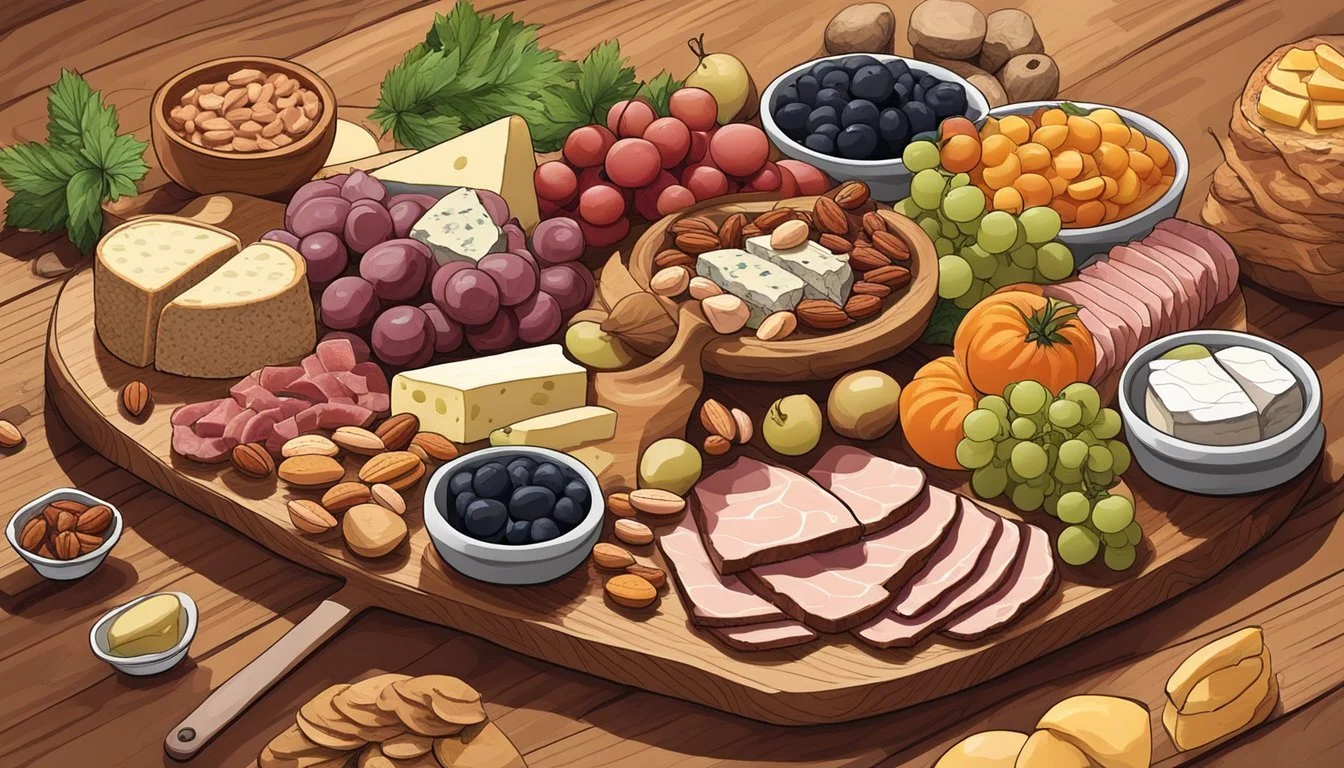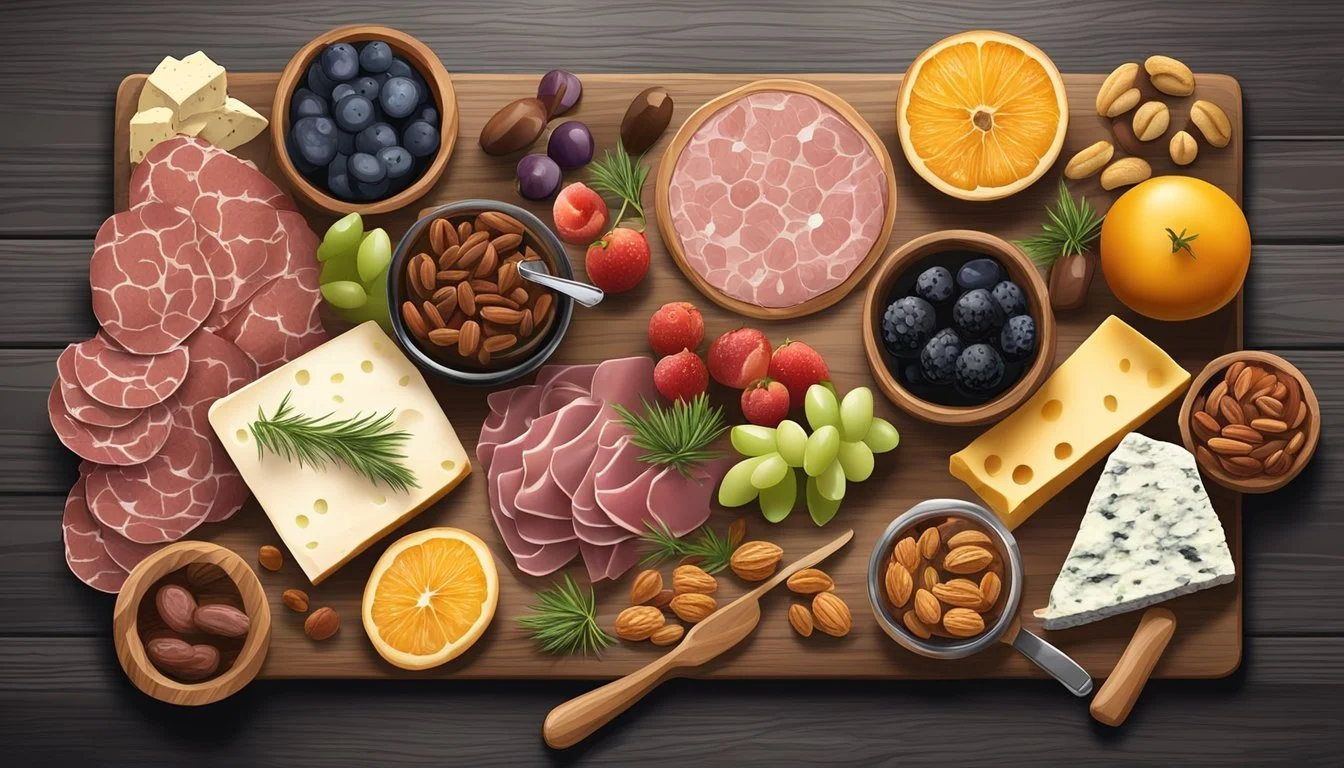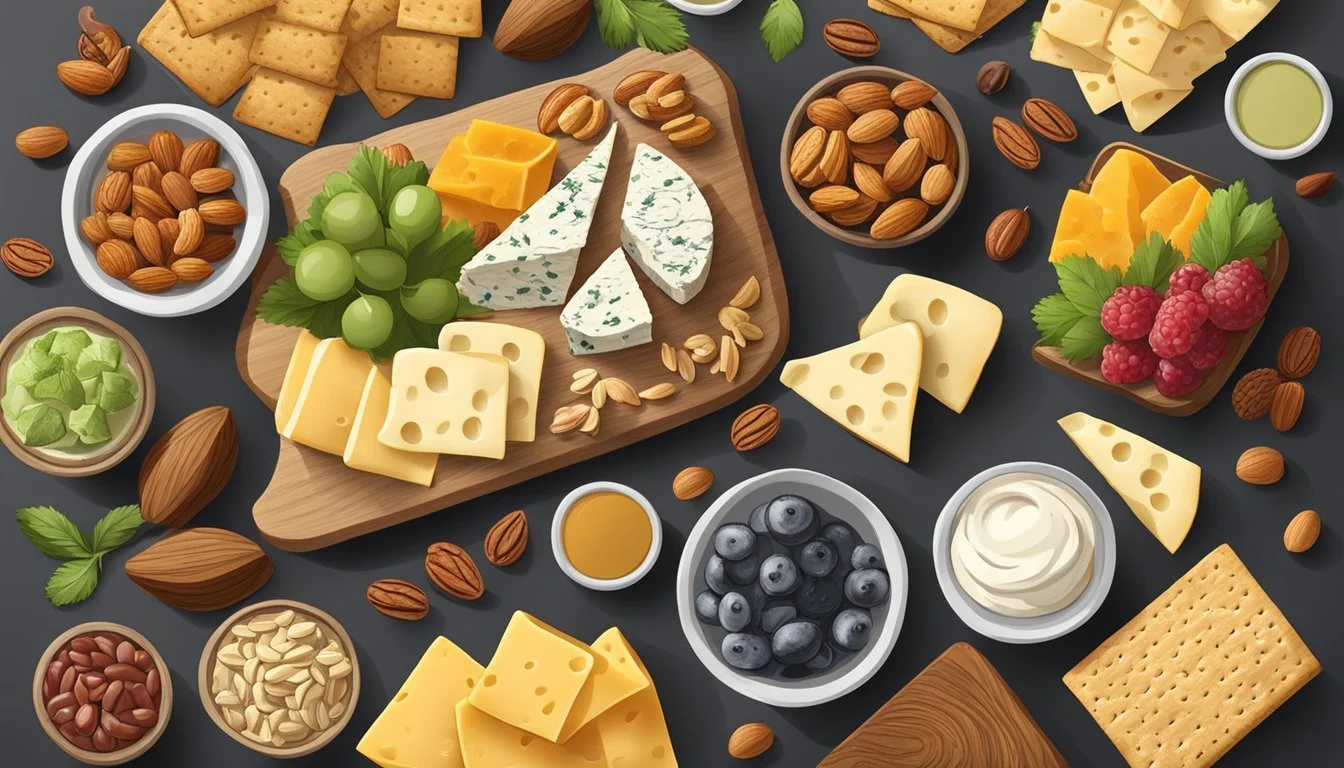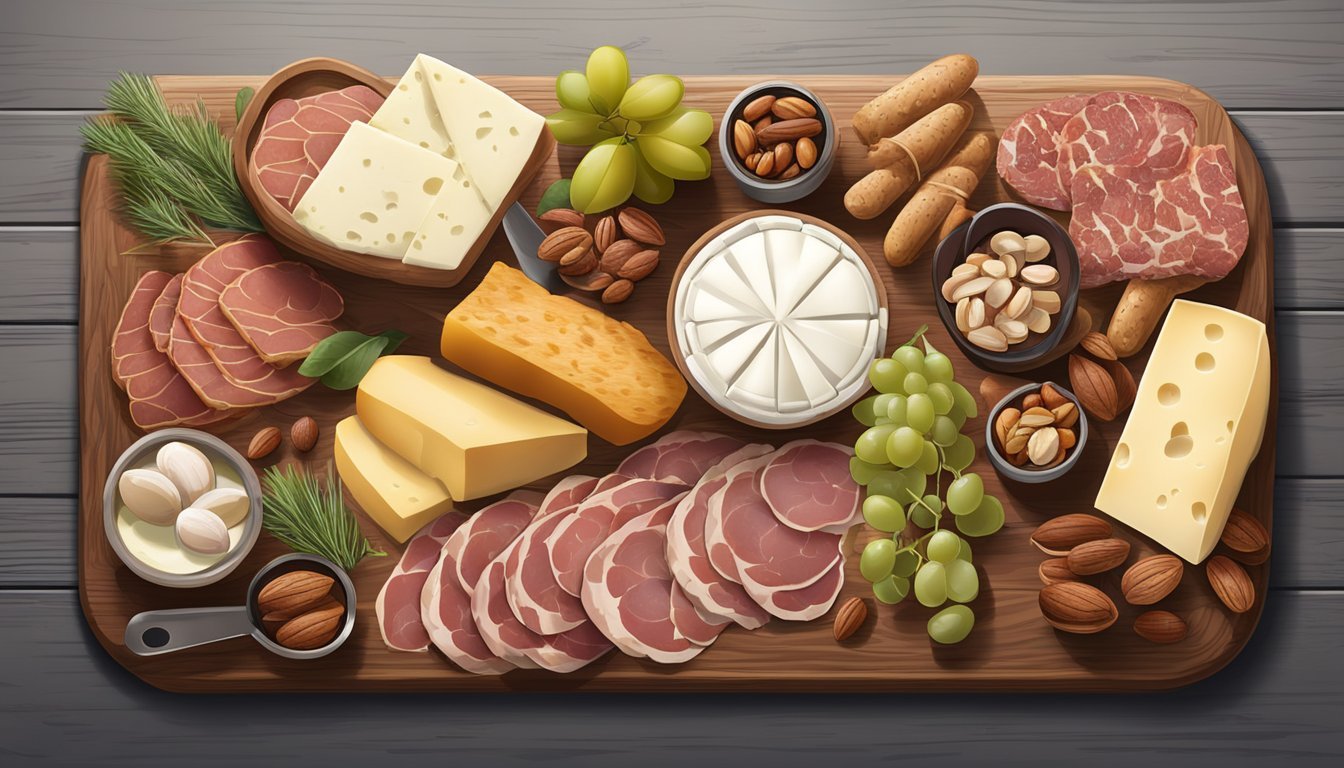How Do You Eat a Charcuterie Board
Expert Tips for Savoring This Delicacy
A charcuterie board offers a delightful array of cured meats (What wine goes well with cured meats?), cheeses (how long does cheese last?), and accompaniments, inviting diners to enjoy a variety of flavors and textures in a communal dining experience. They are masterpieces of culinary artistry and design, balancing savory, sweet, and tangy components. Elegantly displayed, the boards provide an informal, tapas-style meal or an exquisite appetizer that stimulates conversation and taste buds alike. They often feature an assortment of thin-sliced meats, diverse cheeses, and various small bites like fruits, nuts, olives, and pickles, as well as crackers or slices of crusty bread.
The etiquette of eating from a charcuterie (What wine goes well with charcuterie?) board is casual yet mindful, enabling individuals to create their own perfect morsels. Toothpicks, mini skewers, or small tongs are typically provided to allow guests to select and combine items without direct hand contact, maintaining hygiene while offering a personalized dining experience. Meats may be folded or rolled, cheeses can be broken into smaller pieces, and spreads or dips are placed in accessible bowls with utensils for easy scooping.
In crafting the perfect bite, guests may pair the rich, savory flavors of meats with the complementary creaminess of cheeses, the slight tartness of pickled vegetables, (What wine goes well with pickled vegetables?) or the sweetness of fruit preserves. This practice enriches the pleasure of the palate and showcases the intent behind the charcuterie board—savoring a symphony of flavors that collectively enhance each unique component. As visual appeal is nearly as important as taste, color coordination and artistic arrangement play a fundamental role in the presentation, ensuring that each board is not only delicious to eat but also a feast for the eyes.
Essentials of a Charcuterie Board
A well-prepared charcuterie board offers a symphony of flavors and textures, ranging from cured meats to a spectrum of cheeses. It is the centerpiece that can start conversations and please the palate.
Choosing the Right Board
A sturdy and spacious board is the foundation of any charcuterie spread. Common materials include wood, marble, or slate, each adding its own aesthetic appeal. The size of the board should accommodate the number of guests, ensuring a generous display of meats and cheeses.
Essential Charcuterie Meats
Silky, savory cured meats are the heart of a charcuterie board. A selection should include:
Prosciutto: Thinly sliced with a delicate, buttery texture.
Salami: Offers a robust flavor with a hint of spice.
Chorizo: Spanish sausage known for its smoky, garlicky taste.
Typically, one should allocate about two to three slices or 2 to 3 ounces of meat per person to satisfy guests.
Variety of Cheeses
Balance is key when it comes to cheese selection. A charcuterie board should feature:
Hard cheeses: Such as Manchego and Aged Cheddar, that provide a sharp, intense flavor.
Soft cheeses (What wine goes well with soft cheeses?): Including Brie and Goat Cheese, known for their creamy texture.
Blue Cheese: For a pungent, bold taste complementary to sweeter pairings like fruit preserves.
One may also consider Gouda for a nutty note or Manchego for its firm yet buttery composition. Each cheese should be presented with a separate knife to preserve the integrity of flavors.
Accompaniments
A well-assembled charcuterie board features an array of accompaniments that enhance the flavors of the meats and cheeses. Fresh fruits add sweetness, nuts offer a crunchy texture, and various breads and crackers provide the foundation for bite-sized creations. Spreads and dips contribute an additional layer of flavor to each nibble.
Selecting Fresh Fruits
Fresh fruits bring a natural sweetness and a burst of juiciness to a charcuterie spread. When selecting fruits, focus on a variety of colors and textures:
Apples: Sliced for a crisp, tangy addition.
Grapes: Clusters for easy picking and natural sweetness.
Berries: For a pop of color and a hint of tartness.
Nuts and Dried Fruits
Nuts and dried fruits (What wine goes well with nuts and dried fruits?) offer contrasting textures and condensed flavors:
Almonds/Walnuts: For a hearty, earthy crunch.
Dried Apricots/Figs: Chewy and sweet complements to savory cheeses.
Breads and Crackers
Bread and crackers serve as the edible canvas for charcuterie ingredients:
Baguette: Thinly sliced, adding a crusty texture.
Artisan Crackers: Various shapes and sizes, some infused with herbs or seeds.
Additional Spreads and Dips
A selection of spreads and dips can elevate the charcuterie experience:
Jams and Preserves: Such as fig or apricot, introducing a fruity sweetness.
Honey: Drizzled for a touch of natural sugar.
Mustard and Hummus: Ranging from spicy to earthy, these dips add complexity.
Butter: Unsalted, for guests preferring a milder, creamy spread.
Assembling the Board
When one assembles a charcuterie board, attention to detail in arrangement and pairing can transform simple ingredients into a culinary experience. They should consider the variety of textures, shapes, and flavors that make up the board's offerings, ensuring that each element complements the next for a harmonious theme.
Arrangement Techniques
A well-assembled charcuterie board displays an array of textures and shapes that are not only appealing to the eye but also to the palate. The meats should be thinly sliced to make them easy for guests to eat and to allow for a delicate presentation. Cheeses can be cut into different shapes such as cubes, triangles, or slices, adding visual interest. One's arrangement should ensure that each item is easily accessible, preventing any need to move or disturb other elements on the board. Providing small utensils, like toothpicks or tongs, can help guests to neatly select their desired bites.
Pairing Strategies
Effective pairing strategies on a charcuterie board hinge on a thoughtful variety of flavors. Incorporate a combination of hard and soft cheeses, ranging from mild to sharp, to offer a spectrum of taste experiences. Arrange meats of different textures—such as smooth pâté alongside cured sausages—and consider the saltiness and spiciness of each selection. Strategic placement of complementary items, such as placing a robust blue cheese near a sweet honeycomb, will encourage guests to explore flavor interactions. Select pairings that align with a chosen theme; for instance, one might curate an Italian-themed board with prosciutto and Parmigiano-Reggiano, or create a local artisan selection featuring regional specialties.
Serving the Board
When serving a charcuterie board, attention to detail enhances the overall experience. From aesthetics to functionality, the elements of serving are crucial in presenting an inviting spread that is both delicious and accessible.
Presentation Tips
The charcuterie board itself is often a centerpiece, so choosing the right material is important. Wooden platters offer a classic, rustic look, while slate or marble provides a more sophisticated touch. They arrange the meats in thin slices for visual appeal and ease of eating. Cheeses are cut into various shapes and sizes, with some slices and some in block form for guest preference. Accents of color can be added with small bunches of fresh herbs or edible flowers, contributing to the aesthetic appeal.
Maintaining the Right Temperature
To ensure the best flavor, a charcuterie board should be served at room temperature. This allows the fats within the meats to soften, enhancing their natural flavors. Cheeses also benefit from resting at room temperature, becoming creamier and more flavorful. It’s advisable to set the board out approximately 30 minutes before guests arrive.
Serving Utensils and Small Bowls
To facilitate ease of serving, provide a range of utensils. Each cheese should have its own knife to prevent mixing flavors. Toothpicks or mini skewers are recommended for picking up meats and other bite-sized items. Small bowls with spoons should be placed for sauces and dips to keep them contained and to allow guests to scoop out portions easily. If honey is included, a honey dipper offers an efficient and mess-free serving option.
Pairing the Perfect Beverage
When it comes to enhancing a charcuterie board, the choice of beverage is crucial. Wine is a classic pairing, with certain varietals complementing the flavors of meats, cheeses, and accouterments. For a harmony of taste, white wines like Viognier or Chenin Blanc can offset spicy meats with their sweetness and acidity.
Red wines also have their place on the table. A charcuterie board featuring richer meats like salami pairs well with a full-bodied red, allowing the robust flavors to resonate together. On the other hand, lighter meats such as mortadella shine alongside a fruity rosé or an effervescent pet-nat, which underscore the subtle flavors without overwhelming them.
Meat Type Wine Recommendation Spicier Meats Sweet White Wines Rich, Hearty Meats Full-bodied Red Wines Lighter Meats Rosé or Pet-Nat
For those who prefer beer, a crisp lager can cleanse the palate between different types of charcuterie, while a malty ale might complement the savory flavors of smoked or cured meats.
Pairing does not simply rest on the type of beverage but also how it interacts with all components of the charcuterie board. Balance is key. A beverage that is too overpowering can eclipse the delicate symphony of flavors on offer, while one that is too mild may be overshadowed itself. Choosing the perfect beverage requires considering the entire array of items on the board and selecting a drink that can support and elevate the experience.
Charcuterie for Occasions
Selecting the right size and mix of ingredients for a charcuterie board can bring a touch of class and variety to any social occasion. Whether it's an intimate setting or a bustling party, a well-crafted charcuterie board is perfect for grazing and socializing.
Boards for Intimate Gatherings
For smaller gatherings, a charcuterie board should feature a balance of flavors without overwhelming guests. The board might include two to three selections of thinly sliced meats, several cheeses with different textures, a modest assortment of nuts, and a small variety of fruit to cleanse the palate. To complement the meats and cheeses, one can include a seasonal selection of jams or honey, ensuring these condiments are served in small bowls with utensils for convenient spreading or drizzling.
Charcuterie for a Crowd
When serving a larger crowd, it’s important to choose a variety of ingredients that cater to different tastes while also considering efficient serving. The board should be sizable to accommodate larger quantities, offering an array of meats totaling approximately 2 to 3 ounces per person. Including toothpicks, mini skewers, or small tongs can facilitate easy and hygienic sampling. For a visually appealing spread, one might pay attention to color coordination, placing vibrant fruits and vegetables among rich, cured meats and a selection of cheeses. This arrangement not only pleases the eye but also ensures that there is something for everyone to enjoy as they graze throughout the event.
Advanced Charcuterie Concepts
When constructing a charcuterie board, moving beyond the basics can transform a simple selection into an exquisite gastronomic experience. Delving into the less familiar territory of international meats and cheeses, as well as themed arrangements, can elevate the board both in flavor complexity and presentation.
Exploring International Meats and Cheeses
A well-curated charcuterie board often features an array of international delicacies.
Meats:
Prosciutto: This Italian dry-cured ham is sliced paper-thin and offers a delicate texture and a balance of sweetness and saltiness.
Salami: Known for its firm texture and garlic flavor, Italian salami can range from spicy to sweet.
Chorizo: A Spanish or Portuguese sausage with a deep red color, chorizo is known for its piquant smoked paprika taste.
Summer Sausage: An American addition, this sausage is typically seasoned with garlic and mustard seeds and has a tangy flavor and firm texture.
Cheeses:
Havarti: Creamy and smooth, this Danish cheese lends a mild and buttery taste, often with subtle hints of tanginess.
Gruyere: Swiss gruyere is known for its complex nutty and sweet flavor.
Camembert: A soft, creamy French cheese with a bloomy rind, offering a rich and earthy taste.
Country Meat Cheese Italy Prosciutto Not specified Italy Salami Not specified Spain/Portugal Chorizo Not specified USA Summer Sausage Not specified Denmark Not specified Havarti Switzerland Not specified Gruyere France Not specified Camembert
Exploring meats and cheeses from across the globe provides guests with a rich culinary journey and can serve as a conversation starter.
Creative Charcuterie Themes
Themes can add an exciting twist to the charcuterie experience.
Examples of Themes:
Seasonal: Use fruits and accompaniments that compliment the current season.
Cultural: Focus the board around a specific cuisine, such as a tapas-style board with Spanish chorizo.
Occasion-Based: A Halloween board might feature an array of aged cheeses (What wine goes well with aged cheeses?) like Gruyere, paired with meats cut in eerie shapes.
By using a theme, the host can craft a cohesive tasting experience where each element on the board contributes to the overarching concept, challenging guests' palettes and piquing their curiosity.
DIY Charcuterie Board
Creating a DIY charcuterie board is all about personal touch and showcasing flavors. Whether one is an experienced deli connoisseur or a beginner, crafting a homemade board filled with a variety of proteins and accompaniments is achievable. It begins with some homemade recipes to bring uniqueness to the board, coupled with the selection of the finest cheeses arranged meticulously.
Homemade Charcuterie Recipes
Meats play a central role in charcuterie boards. They suggest starting with three to five homemade charcuterie choices to offer a range of flavors and textures. Examples include:
Prosciutto: Thinly slice this dry-cured ham to include a rich and savory option.
Salami: Create different varieties, incorporating garlic or peppercorns for a flavorful punch.
Pâté: For a spreadable protein, pâté made from liver, seasoned with herbs and a splash of brandy, adds a luxurious element.
Recipe Ingredients Preparation Prosciutto Pork, sea salt Cure for several months, slice thinly Salami Ground meat, garlic, peppercorns Ferment and air-dry before slicing Pâté Liver, herbs, brandy Blend until smooth and refrigerate
Crafting the Ultimate Cheese Board
For the cheese board within the charcuterie spread, balance is key. Include a variety of textures and flavors:
Soft cheeses: Brie or camembert provide a creamy and smooth choice.
Hard cheeses: Like aged cheddar or manchego, they add a firm texture and rich depth.
Blue cheeses: (What wine goes well with blue cheeses?) Offer a pungent, sharp taste that contrasts well with milder flavors.
Accompaniments should also not be forgotten; they are crucial in complementing the board:
Fruits: Grapes, figs, or dried apricots add sweetness and texture.
Nuts: Almonds or walnuts provide a crunchy element.
Pickles and olives: Include this for acidity and tang.
One should aim to serve the cheese at room temperature to ensure the flavors are at their peak. Present the cheese in different shapes, such as cubes, slices, or wedges, to add visual interest to the board. Use small bowls for pickles and dips, and scatter the nuts and fruits around the board. Each cheese can be served with a dedicated knife to maintain the integrity of the flavors.






